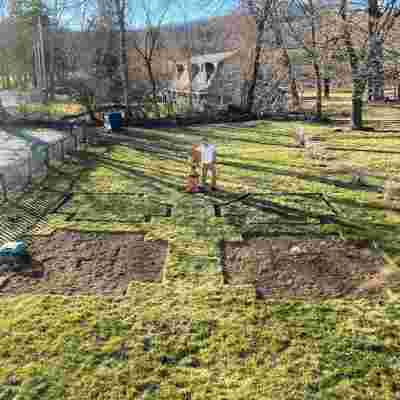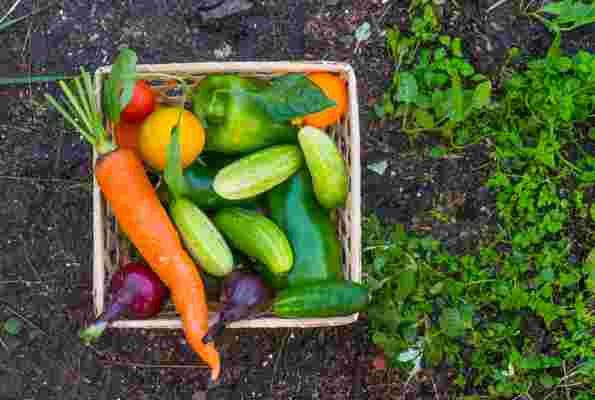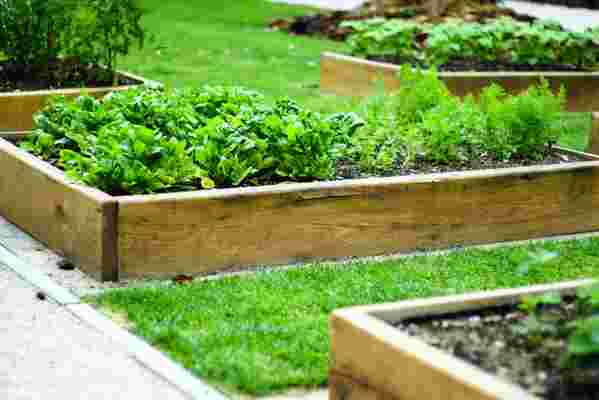It’s been a few weeks since the COVID-19 pandemic halted the world, forcing us to retreat into our homes and forgo physical social contact—and it doesn’t look like we’ll be freed any time soon. Though grocery stores are open for business, authorities from governors to the Centers for Disease Control and Prevention (CDC) have asked that we minimize our outings into the public world, which got us thinking: what better time to plant your own vegetable garden? Not only could this help you skip the trip to the store once the produce comes in, but it also could provide some much-needed stress relief. We asked some gardening experts for tips and tricks to design a garden and grow produce in your backyard or patio.

“Anthony Bellomo, my partner, is a landscape architect and he did the plan and has started to work on it,” says designer Christopher Spitzmiller. “The beds can both be pretty and practical. The inset corners allow for easy access to the beds, so you don’t have to stand in them and compact your soil to work and harvest.”
Designing a Garden
Before you dive in with your trowel and seeds, you’ll want to spend some time designing your garden’s layout. Start by observing how much sunlight is in your yard or patio. “Consider where the vegetable garden is going. It should go in the sunniest spot, as most vegetables require lots of direct sun,” says landscape designer Kathryn Herman . But don’t fret if you have a little bit of shade. “Some vegetables, like salad greens, can take a small amount of shade,” says landscape designer Deborah Nevins .
When it comes to designing a layout, keep in mind that gardens take work. You’ll need to be out there watering, weeding, and harvesting, so you’ll want to leave areas between your beds where you can tread safely. “We like making the garden beds easy to access, so a three-foot-wide by eight-foot-long bed with space on either side allows circulation to get to both sides,” says Herman. “The space on either side of the bed can be lawn, or it can be gravel, or it can be a paved surface.”
And if you don’t have a full yard, don’t worry—there are plenty of ways to make do with a small space like a patio, a window box, or even a section of your driveway. “Plant in containers or a small raised bed,” says Tara Nolan, author of Gardening Your Front Yard and co-owner of Savvy Gardening . “You just need to make sure the space gets at least six to eight hours of sunlight a day. There are many compact plant varieties that are perfect for small spaces. Look for words like mini, dwarf, or patio on seed packets.”

Cool weather crops include carrots and other root veggies.
Choosing What to Plant
There’s quite a variety of produce to choose from for your vegetable garden, and the good news for beginners is that it’s relatively easy to grow the vast majority of them. “Plants are really simple, especially vegetable plants,” says Shelby DeVore, founder of homesteading website Farminence . “There are two main types of vegetable plants that are suitable for first-time gardeners: fruit crops like tomatoes and cucumbers, and vegetative crops that are grown for their leaves, like spinach and lettuce.”
To help you narrow down your selection, consider the size of your garden—and the colors you want to see. “There is a large variety of tomatoes, peppers, eggplants, and lettuces that come in many forms and colors, which can add another level of interest to the garden,” says Herman. “These vegetables are suitable for a smaller bed, while vegetables like squash, cucumbers, and melons require more space to spread out.”
Something else to think about: Some plants grow better during different times of year. “Cool-weather crops like peas; root veggies like beets and carrots; and members of the Brassica genus, like cabbage, kale, and brussels sprouts, can be sown in early spring, while the heat-lovers like tomatoes, melons, and cucumbers are planted after all threat of frost has passed,” says Nolan. “Google your region and the area’s frost-free date, which will help you know when to plant.”
And, of course, grow what you want to eat! “Red Russian kale is one of my personal favorites,” says designer Christopher Spitzmiller . “It’s easy to grow and has nearly flat leaves that are easy to roll up and cut into small coleslaw-like pieces that make a great salad all summer and into the early winter.”

Make sure to research your region to know when to plant certain seeds.
Gardening Tips
Follow these tips from our experts and you’ll be on your way to self-grown fresh produce in no time!
1. Consider starting your garden indoors if it’s still cold out
Although it’s just about the right time of year to get outdoors, you can start your garden inside if you’re in a colder climate. “We have lots of seeds started under grow lights in our garage,” says Spitzmiller. “We’ve started all sorts of lettuces, cabbages, and arugula.”
2. Make sure you’re using good soil
When it comes to gardening, it’s crucial to have healthy soil for robust growth. “You have to determine the quality of your soil regarding nitrogen, phosphorus, and potassium, and you need to see if the soil drains well,” says Nevins. And don’t forget fertilizer! “Composted manure can be worked in to help add organic matter into the soil,” says Herman.
3. Check on them daily
Pay attention to your plants, as their physical appearance can alert you to any issues they might have. “Plants that aren’t getting enough water will be droopy, but most people know that,” says DeVore. “They’ll also let you know if they have a disease or nutritional issue. Check the leaves for yellow or brown spots. Wilted, yellow, purple, or curled leaves can be a sign that something is wrong.”
4. Don’t get discouraged
“First-timers should know that even the most experienced gardeners can have issues, and not to be discouraged,” says Nolan. “Sometimes issues like pests, or even excessive rain, can affect crops. The key is to figure out what went wrong and how you can mitigate those circumstances next time.”
